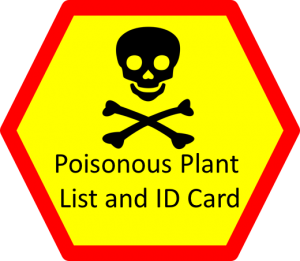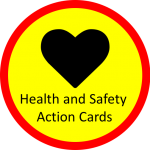Poisonous plants can cause temporary or permanent damage if too much is eaten and then absorbed by the body. Poisons from plants as well as being swallowed, may enter the body through inhalation, injection by the plant(e.g. thorns) or absorbed through the skin.
Swallowed plant poisons include stems, leaves, berries, bulbs and seeds. There are a whole variety of poisonous plants indigenous to the UK (click the image below to see a comprehensive list of the most poisonous and their individual ID cards).
The best treatment for ingestion of poisonous plants is prevention. Prevention can be achieved through:
- education and clear ground rules for your group. Making sure all members understand that plants can be poisonous and shouldn’t be ingested.
- ensure secure identification of plants when foraging.
- washing hands before eating.
Mild Poisoning
If a plant, which causes mild poisoning, is consumed there are a few simple things you can do. However, if any more serious symptoms appear, it is best to follow the severe poisoning advice below. For mild poisoning:
- Do not make the patient sick.
- A class of water or milk can be soothing.
- Irritation in the mouth can be relived with something cold e.g. ice cream.
Severe Poisoning
Symptoms – If you suspect that a forester has ingested a highly poisonous plant then there are a few key warning signs to watch out for.
- Nausea and vomiting
- Cramping Stomach Pains
- A burning Sensation
- Partial Loss of Responsiveness
- Seizures
Actions/ Treatment – If you suspect potentially harmful poisonous plants have been ingested then:
- If possible determine what has been consumed. Firstly, if the patient is conscious ask the what they have eaten, when they ate it and how much they ate. If the patient is unconscious or too young to understand then look for clues e.g. poisonous plants or berries nearby or areas where a plant has clearly been eaten.
- Call 999 or 112. It is important to provide as much information as possible about the patient and the poison.
- Whilst waiting for emergency services keep checking breathing, pulse and the patients responisveness.
- If patient becomes unresponsive open the air way and check breathing, if breathing then put the patient in the recovery position and keep monitoring their airway.
- Patients who stop breathing should be treated using your CPR training.
Warning – Never induce vomiting after a patient has consumed something poisonous. If the patient vomits naturally then put it into a bag or plastic box and hand to the emergency services on their arrive.
If going out in the field you may find it useful to take a set of these Flora and Fauna Health and Safety Cards they act as a reminder of what to do in an Emergency should arise. Often these can be stressful situations and a simple reminder can be very helpful. Click on the link below to access the cards.


